How to Set Up a Winning Sales Enablement Program
Casey O'Connor
Contents
Sales enablement is the practice and process of equipping your sales team with the skills, content, training, or guidance they need to:
- increase their productivity,
- systemize their selling process, and
- close more deals.
Sales enablement is becoming a bigger priority for more and more startups and small businesses; meanwhile, companies who already prioritize sales enablement can testify to the serious benefits it provides to their bottom line.
In this article, we’ll go over everything you need to know about sales enablement, and why you should consider creating resources for implementing this process in the near future.
Here’s what we’ll cover:
- What Is Sales Enablement?
- Why Is Sales Enablement Important?
- How to Know if You Need Sales Enablement
- Who Owns Sales Enablement?
- How to Design a Sales Enablement Strategy
- How to Measure Sales Enablement
- The Best Sales Enablement Tools
- Sales Enablement Team Roles
What Is Sales Enablement?
The primary goal of sales enablement is to enhance relationships between buyers and sellers. A sales enablement program is designed to provide salespeople with the tools, training, or resources necessary to add more value to their interactions. 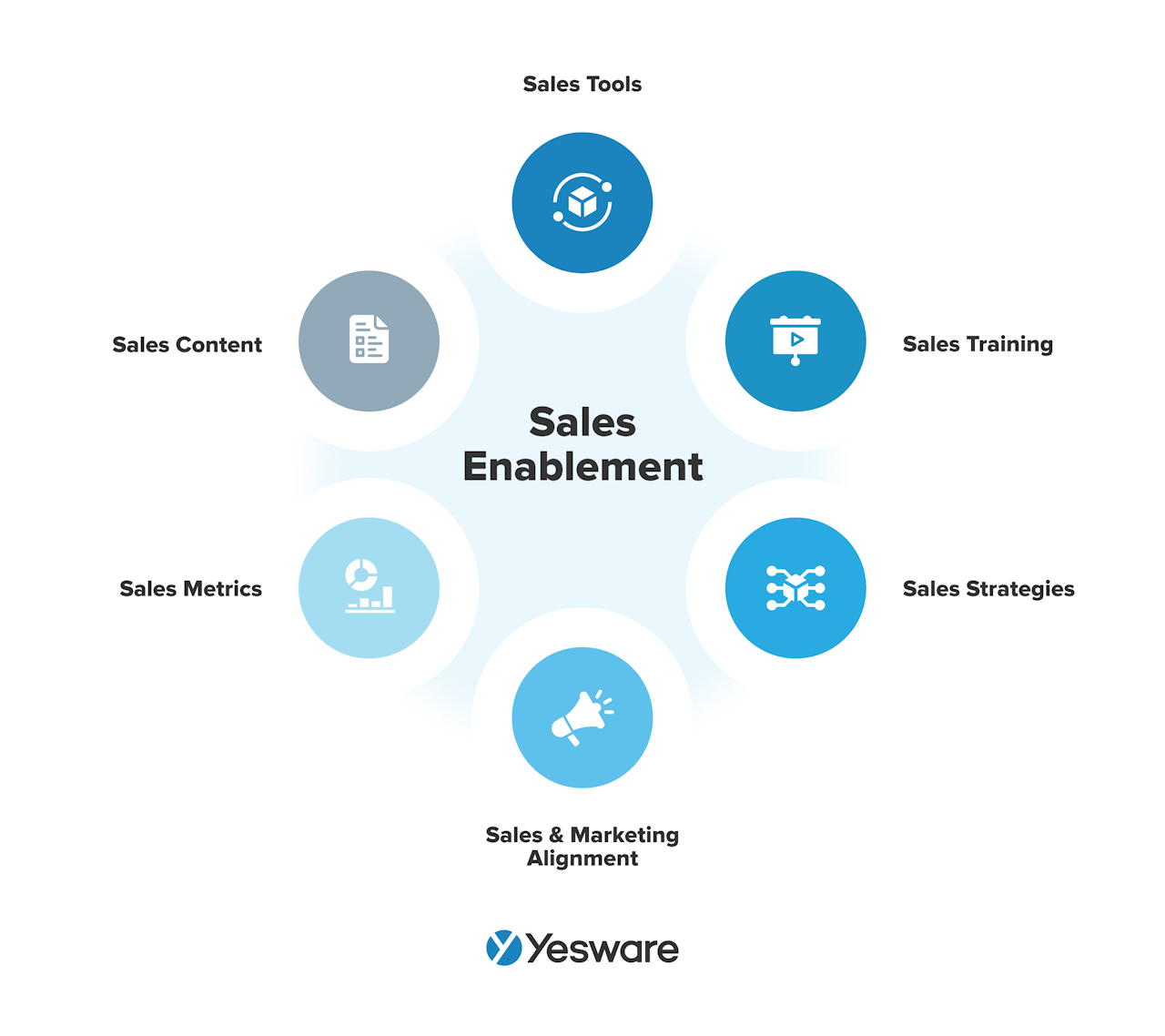 Sales enablement is an umbrella term and can represent any combination of several resources and/or activities on behalf of the sales enablement team. Sales enablement reps can offer:
Sales enablement is an umbrella term and can represent any combination of several resources and/or activities on behalf of the sales enablement team. Sales enablement reps can offer:
- Content creation and/or content organization
- Design/execution of a sales training or coaching plan
- Day-to-day sales tool management
- Streamlining of the onboarding process
- Refinement of branding and messaging
- Visibility into customer behavior
- Optimized sales pitches
To put it simply, the sales enablement process provides salespeople with the information, content, and guidance to effectively engage prospects and convert them into buyers.
Effective sales enablement has been shown to:
- Increase revenue (measured by an increased conversion rate)
- Improved customer acquisition (quantity and cost)
- Allow for more time spent on selling activities
That last one — time spent on selling activities — is particularly important. Studies show that salespeople only spend about 36% of their time on revenue-generating sales activities; the other ⅔ of their time is spent on administrative or non-sales activities, like data entry.
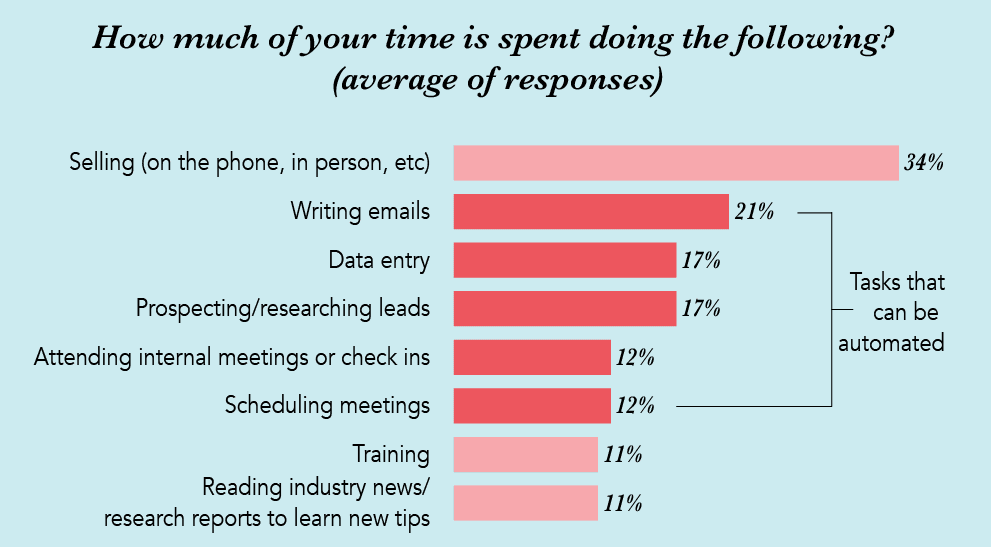
This data indicates that a whopping 79% of salespeople’s time is wasted on things that could be automated. Sales enablement can identify gaps like these and implement productivity-boosting sales tools.
Sales enablement responsibilities include creating and managing content meant for external consumption. These are things that the customer will ultimately interact with, like blog posts or white papers.
They’re also responsible for creating internal content, such as onboarding guides, how-tos, battle cards, pitch templates, conversation guides, and coaching content.
Ultimately, the combination of tools, coaching, and content developed by sales enablement will depend on each company’s unique needs. With that being said, there are some basic and universal tenets of any successful sales enablement program.
Customer-Centric
While it’s true that sales enablement is tasked with improving reps’ sales readiness, their job is actually a bit more specific than that; that is, in order to have the best results, they need to design their enablement program around the customer journey.
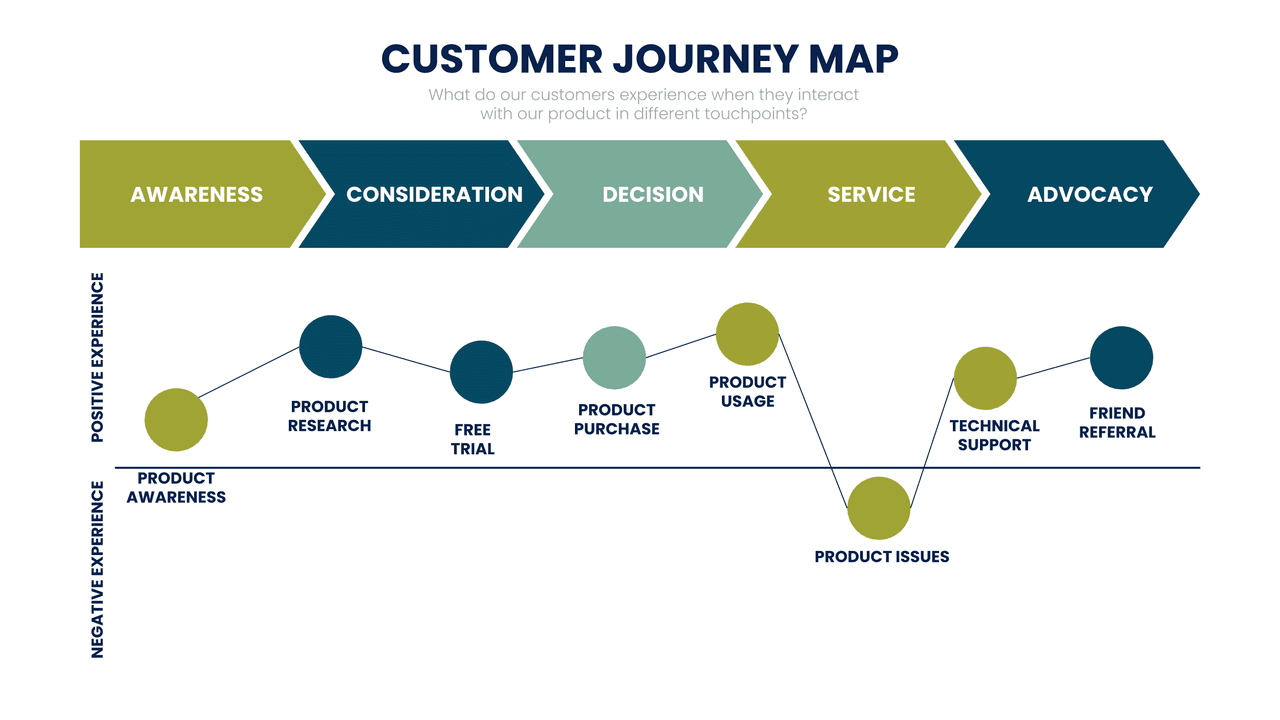
In other words, it’s the job of sales enablement to anticipate what buyers will need at each stage of the buyer’s journey, and then connect salespeople with the right content to fill those needs. If said content doesn’t exist, it’s up to sales enablement to create it.
Data-Driven
The best sales enablement teams know that it isn’t enough to simply offer training and write blog posts; the sales enablement strategy needs to be tailored around a company’s unique operation process, goals, and challenges.
To that end, your sales enablement strategy needs to be data-driven. It should lean heavily on insights from historical sales data, and be designed around moving the entire salesforce toward reaching and exceeding their quotas.
Systematic
One of the marks of a highly effective sales enablement program is the development of a framework or template for customized content and pitches.
In today’s sales landscape, the bottom line is this: buyers want to buy from sellers who earn their trust and offer value. Sales enablement teaches salespeople how and when to offer that value, and in the form of what content.
Not only that, but sales enablement can also teach salespeople how to make this process predictable, repeatable, and scalable.
The best and most effective sales enablement teams are more than just training managers — they are business partners.
Why Is Sales Enablement Important?
Sales enablement exists to make the sales process more efficient and effective. The people and tools that make up the sales enablement department care most about making more sales of greater value — and closing them more efficiently — to improve the bottom line.
The nice thing about sales enablement is that it offers salespeople tools and processes to achieve these lofty aspirations.
Sales enablement also provides sales teams with the training, coaching, and sales collateral they need in order to meet and exceed their goals in an orderly way.
Sales enablement is also critical to sales organizations because its mission can be successfully applied to each and every member of the team. Top sales performers benefit from sales enablement with easy access to their best-selling materials. Mid- and low-performing sellers benefit from the training and coaching that comes standard with a sales enablement program.
All salespeople who have access to sales enablement resources can look forward to:
- A smoother and shorter sales process
- Easily-accessible sales content
- Increased productivity
- Alignment between all revenue-generating teams
Finally, sales enablement benefits sales teams long-term because their initiatives encourage a culture of continuous learning. It allows salespeople to push themselves and take controlled and informed risks in the name of uncharted success. These, in turn, lead to loyalty from top-performing and eager-to-learn sales reps that will stay on with your team for the long haul.
How to Know if You Need Sales Enablement
The short answer here is this: if you want to stay competitive, you should start seriously considering developing a sales enablement program. Sales enablement programs are on the rise, and they seem to be here to stay.
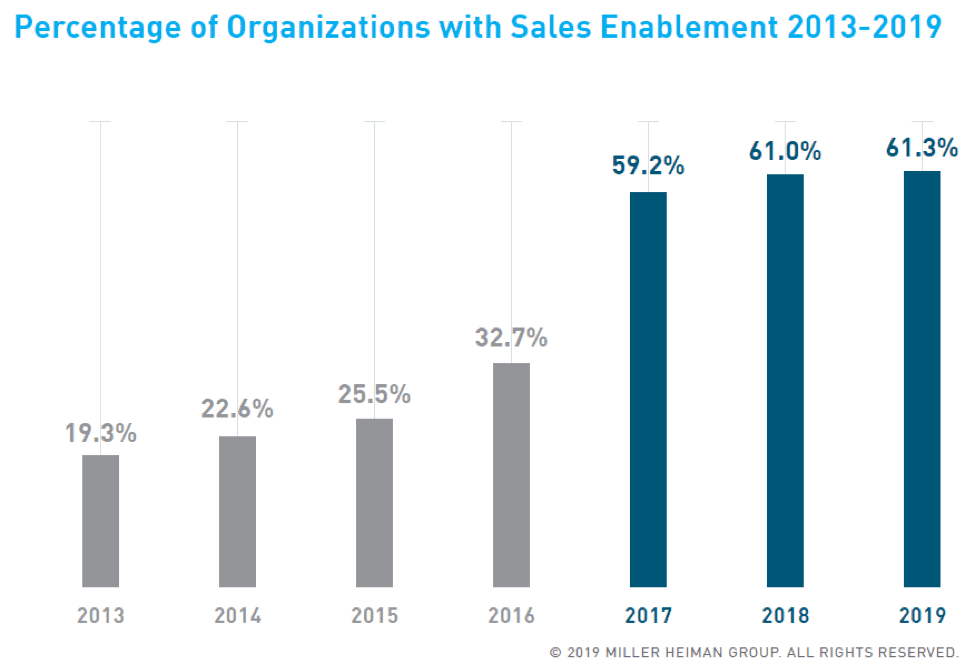
Recent studies have shown that companies who implement one have a 15% better win rate than those who go without.
That’s not all. Studies show that companies with effective sales enablement teams have also shown to have:
- 32% higher team sales quota attainment
- 24% individual quota attainment
- 23% higher lead conversion rate
With numbers like that, it’s hard to imagine why a salesforce wouldn’t welcome the partnership of a sales enablement team.
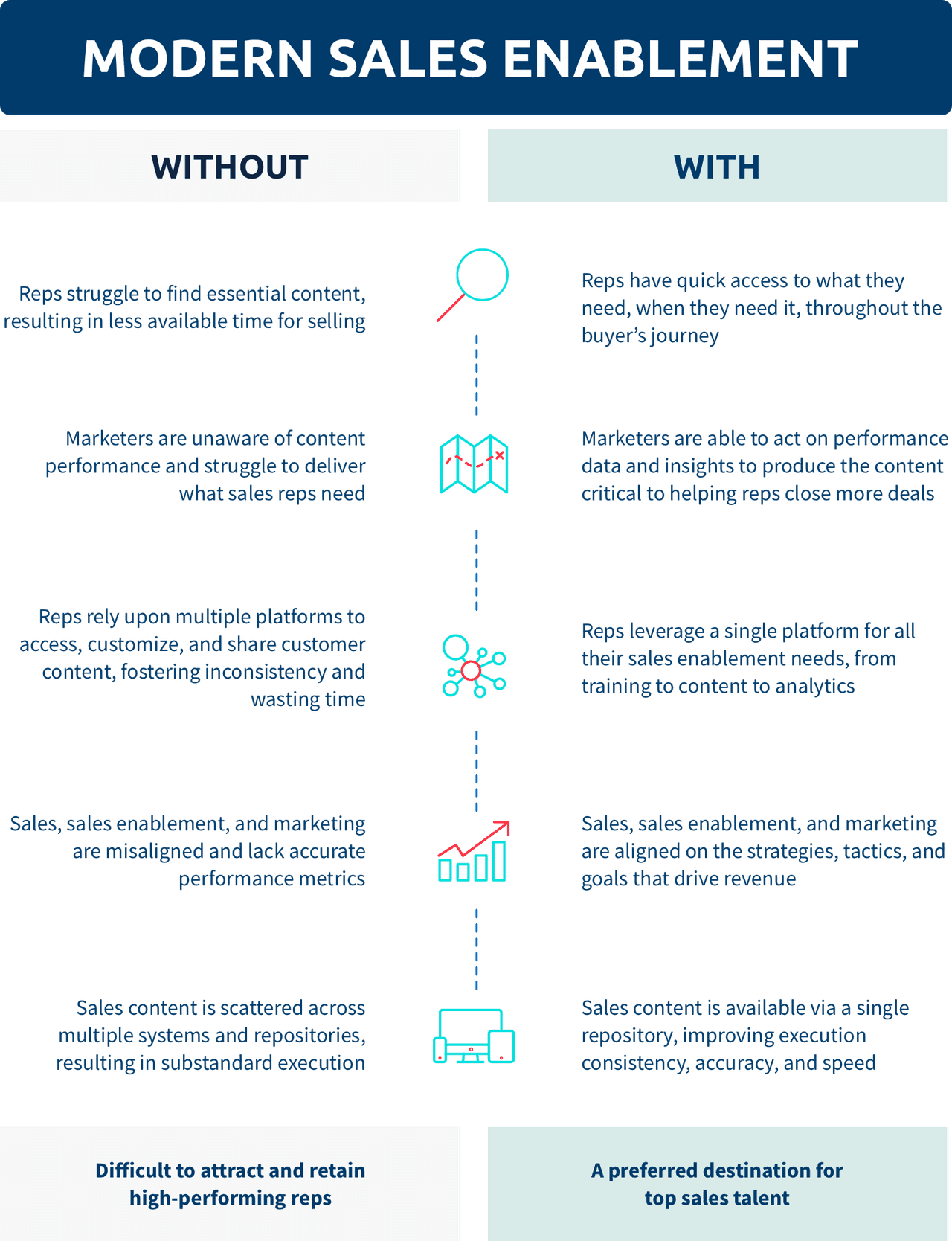
Of course, there will be sales organizations who are still on the fence about whether a sales enablement program might be beneficial to them.
Decision-makers in that position should look out for any of the following, all of which are surefire signs that your salesforce is in need of some more structured guidance.
Not Meeting Goals
If you feel confident that your company is attracting top sales talent, yet you find that your team still isn’t meeting their quotas or other goals, it may be time to call in a sales enablement team.
Your salesforce might very well be packed with talent, but even the best sales reps still need content ready and available for them and the skills and training to use it as effectively as possible. In fact, many sales reps say that having readily available content can easily make or break most deals.
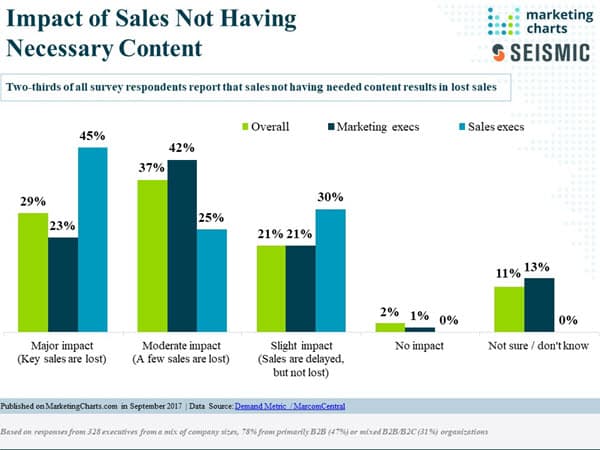
Unclear On Messaging
Even the most minor miscommunication or misunderstanding between internal teams can translate to subpar brand messaging. If you’re noticing a gap or mismatch in branding between sales and marketing, for example, sales enablement can help.
One major problem plaguing salespeople today is the fact that content is sometimes created in isolation of the brand for the sake of creating it quickly. Most companies can get away with this for one or two pieces of content, but it becomes problematic when the full suite of available material has all been created piecemeal. This kind of content can be difficult to use cohesively, and equally difficult to track down at the right time.
Sales enablement can help your sales team:
- Take stock of the existing content available to your reps,
- Finetune it so that the messaging is clear and consistent
- Organize it so that it’s readily available to reps when they need it.
Customers are most likely to buy from brands they trust, and cohesive messaging and content go a long way in creating a trustworthy impression.
Unclear Implementation of Sales Tools
It’s no secret that the technology and tools available to salespeople today are more capable than anything we could have even dreamed up only 10 – 15 years ago. These advancements have the potential to ease many burdens in the day-to-day work of a salesperson — that is, if they can keep up with how to use them all.
Sales enablement teams can help sales reps stay current on the sales tools available to them. In some cases, sales enablement can even step in and manage these activities themselves. The logistics will be up to each individual company, but sales enablement should be one of your first ports of call if you find that you have powerful tools at your disposal that perhaps aren’t being used to their fullest potential.
When in doubt, keep in mind the three major pillars of sales enablement:
- Content
- Training
- Coaching
If any of these resonate as something your sales team might benefit from, it’s time to start building out the department.
Who Owns Sales Enablement?
Sales enablement is typically “co-owned” by both the sales and marketing teams. This may seem counterintuitive because sales enablement exists to support sales, but marketers actually play a pretty large role in a successful sales enablement solution.
Both teams should collaborate to equip salespeople with the relevant marketing content needed to nurture customer relationships and move more potential customers through the funnel.
In some cases, higher-level executives and/or sales operations might also take some responsibility for managing and evaluating sales enablement efforts.
How to Design a Sales Enablement Strategy
How your team approaches sales enablement will ultimately depend on the specific needs and goals of your sales team. You may, for example, feel confident that your salesforce has had ample training, but needs help navigating the relevant content available for them — sales enablement can help here.
Or, perhaps you feel confident about the accessibility of your content, but notice that many of your reps need help putting insights from sales analytics into practice. Sales enablement can help here, too.
That being said, sales enablement is not a one-off program. It’s not a get-in-and-get-out situation, where they arrive for three hours of training and then move on to the next company.
The best sales enablement programs are ongoing, strategic, and will change over time according to sales enablement best practices.
Sales Enablement Best Practices
1. Create a Charter
In order to get the most out of our sales enablement program, you’ll first want to create what LinkedIn calls the “Sales Enablement Charter.”
Here, your sales, marketing, and sales enablement teams (sometimes sales operations, too, where applicable) will outline the goals and expectations of the program. The charter will also describe the methodologies and practices to implement in order to get there, as well as the methods of measurement.
2. Evaluate your Current Operating Status
If you’ve made the decision to work with a sales enablement team, there’s a chance you’re not satisfied with the current sales performance of your team.
If that’s the case, avoid burying your head in the sand about how things are currently going. Crunch the numbers and take stock of the various KPIs the way they currently stand. Having a realistic picture of your team’s current level of performance will help you set goals and devise the most effective sales enablement program.
3. Align to the Buyer’s Journey
Remember, the most effective sales enablement teams are the ones who design their sales playbooks around the buyer’s journey.
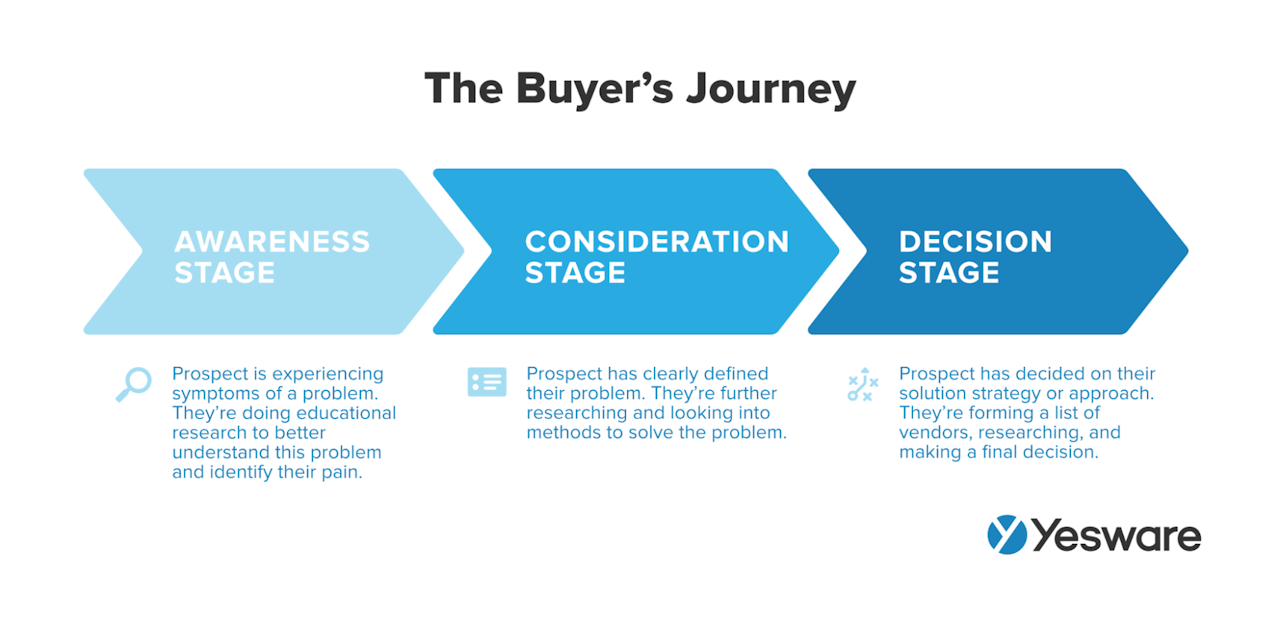
Any content, training, or coaching should be framed in terms of the customer’s needs and how to offer them value.
4. Inventory
Once the basic framework is mapped out, it’s time for sales, marketing, and sales enablement to inventory your business’s existing content and training opportunities. Again, these should be aligned with the needs of the buyer and specific stages of the sales cycle.
5. Fill in Gaps
After you’ve inventoried your current enablement initiatives, it’s time to make a plan to fill in any gaps. Your sales enablement team should create content and training or coaching opportunities as needed to round out any holes in the process.
You may find that your team needs case studies, white papers, or email templates. It could be that the entire prospecting stage needs automation or additional content. Be targeted and specific with your evaluation here, and implement anything that will add value to the buying process.
At this stage, sales enablement should also make sure any customer-facing content is consistent with both branding and internal training.
6. Standardize Metrics
As is the case with any new sales initiative, it’s extremely important to make sure everyone on your team is well-versed in the data and metrics you use to evaluate sales performance.
Take time with the various stakeholders in the process to standardize your KPIs and sales metrics, both what they each represent and how you’ll measure them. Everyone should be working towards their sales goals using the same benchmarks.
7. Implement Sales Enablement Technology
It’s now time for sales enablement to plug into any sales tools available to the team. Here, they might automate prospecting, set up drip campaigns, or enable attachment tracking to monitor buyer engagement.
It’s up to sales enablement to leverage the full functionality of every tool and technology available to the sales team to maximize sales productivity.
8. Improve and Scale
It’s likely that the sales process will continue to have kinks and gaps during its first few cycles with sales enablement; this is to be expected. Sales leaders should continue to work closely with sales enablement to tweak and refine the process until it’s optimized.
Once the various stakeholders feel that sales process optimization has been reached, the sales enablement team should act as a feedback loop between prospects and the customer success, marketing, and sales teams.
How to Measure Sales Enablement
There are a number of ways to track the effectiveness of your sales enablement program. The best ones for your company will depend on your Sales Enablement charter, and what specifically you set out to accomplish by developing your enablement program.
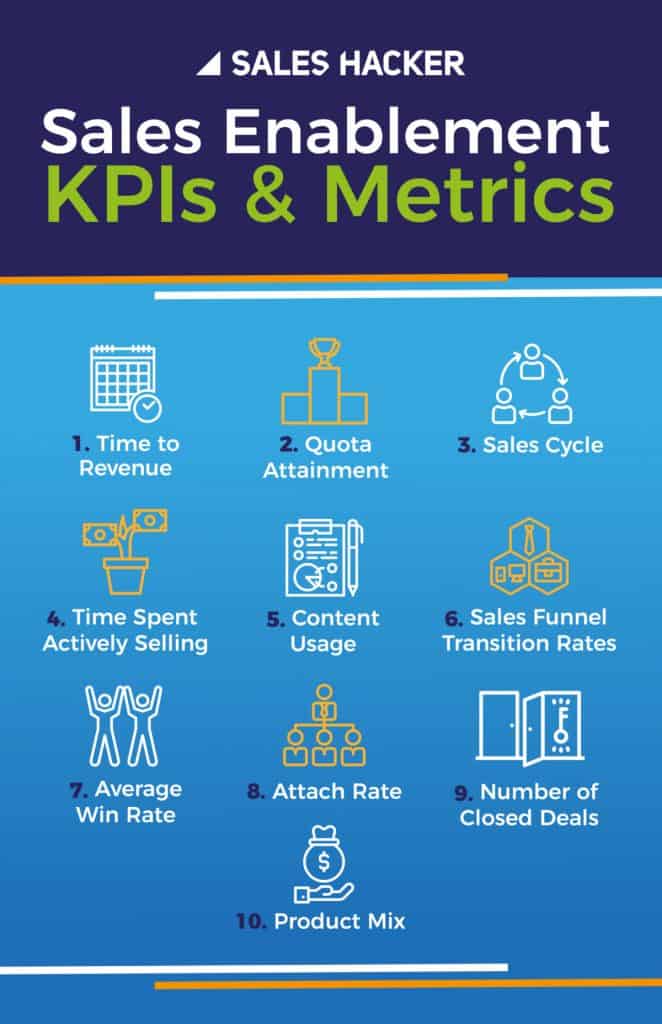
With that in mind, there are a number of KPIs that can give your sales managers a good general idea of how well your sales enablement team is truly performing.
Lead-To-Customer Conversion Rate
Your lead-to-customer rate will typically act as the pulse of any sales enablement program. After all, the primary goal of this sales field is to help salespeople close more deals, more quickly.
You should see your conversion rate start to climb soon after implementing some of the team’s strategies. If you don’t, you may need to go back to the drawing board to refine your plans.
Quota Attainment
Just like your overall conversion rate, your quota attainment rates can shed a lot of light on the overall effectiveness of your sales enablement initiatives.
Quota attainment rates can provide more granular data than the overarching conversion rate, and can offer insight into specific reps and/or stages of the sales cycle that need more training or tweaking.
Time Spent Selling
One of the primary benefits of sales enablement is the way they alleviate salespeople of non-revenue-producing activities. Tracking how much time your sellers are able to devote to true “selling” activities will shed light on how well sales enablement is doing their job.
If your sales reps are still spending excessive time on administrative tasks like CRM management, it might be time to rethink your enablement approach.
Content Performance
Most sales enablement software allows you to track the engagement rates of individual pieces of sales content, as well as overall sales campaign efforts.
Your sales enablement team should constantly evaluate how well your content engages your buyers. Anything that doesn’t make the mark should be refined or replaced entirely with something more relevant.
The Best Sales Enablement Tools
Sales enablement professionals should be well-versed in the sales cycle, buyer needs, and how to create content that speaks to client pain points. They also need to know how to communicate between sales and sales-adjacent teams, and should be able to offer real-time guidance on how to improve the selling process for both rep and buyer.
The many jobs of sales enablement are made easier by powerful sales enablement tools and software. Here’s a look at the various types of tools available to these professionals, as well as a few of our favorites of each.
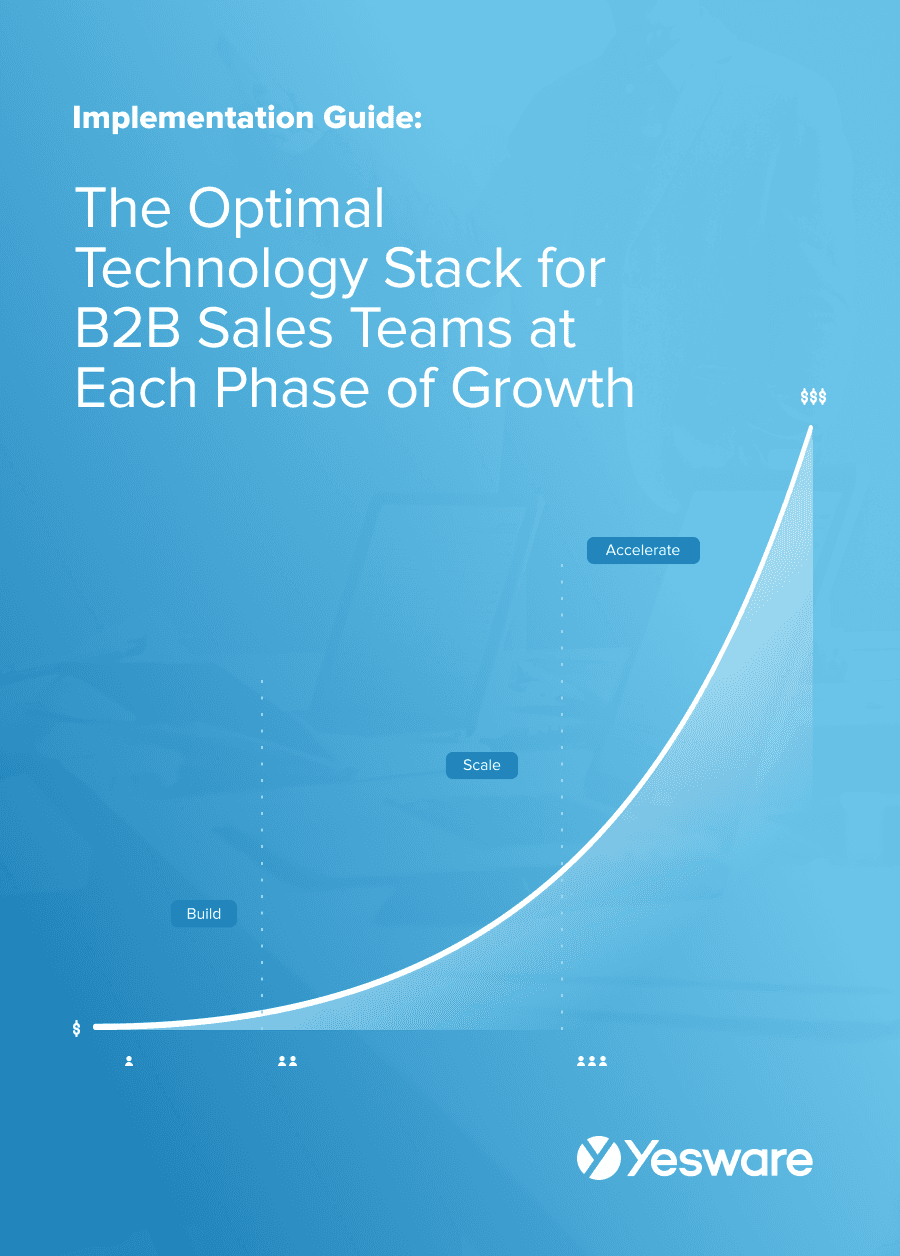 The Optimal Technology Stack for B2B Sales TeamsUsing data from the most successful business-scaling models, we designed a blueprint for the exact technology your business needs at each phase of growth.
The Optimal Technology Stack for B2B Sales TeamsUsing data from the most successful business-scaling models, we designed a blueprint for the exact technology your business needs at each phase of growth.
Business Intelligence & Analytics
This kind of software can gather and aggregate historical and current sales data in easily accessible ways. This data helps the sales enablement team know what stages of the sales cycle need the most immediate attention.
Oracle Business Intelligence is software that enables sales teams to foster a data-driven culture with powerful, visually-impeccable analytics. Software like this enables sales leaders to make efficient, informed, data-driven business decisions.
Content Management
A content management system (CMS) is designed to manage the creation, modification, distribution, and performance of all the content used in the sales cycle. The CMS helps salespeople organize, find, and promote the right sales assets at the right time.
Seismic aligns your people, your process, and your content to deliver a highly personalized and engaging sales experience, at scale.
Sales Productivity
There are many moving pieces when it comes to sales — prospecting, outreach, follow-ups, booking meetings, etc. Sales productivity tools help sales teams connect with more buyers in less time.
Yesware is an all-in-one toolkit for sales professionals that includes tools such as email templates, prospecting campaigns, email tracking, email analytics, and more. The inbox add-on provides teams with the tools to take action and the data to make decisions.
CRM
Nearly every sales organization these days leverages the power of a customer relationship management software (CRM). CRM is technology that helps manage all of your company’s interactions, relationships, and progress benchmarks with their various customers. Put simply, the CRM helps manage customer data.
Salesforce is one of the most well-known CRMs available to sales enablement teams. It can help your sales team manage contacts, forecast with accuracy, and automate administrative tasks.
Lead Generation
This kind of software helps you research and populate your prospect pipeline at scale. Lead generation tools automatically generate and collect leads from a variety of different channels, making it easy for sales reps to fill the top of their funnel with pre-researched “good fits.”
Unbounce helps you create custom landing pages that prompt your visitors with one focused goal: opting in. Their landing page and popup strategy promises to convert more website visitors into bonafide leads.
Sales Enablement Software
There’s a handful of specific software that speaks to the many needs of sales enablement professionals. These softwares allow your enablement team to manage all of your training materials, coaching progress, and internal and external content in one streamlined hub.
Allego is a sales enablement platform that integrates learning, content, and collaboration for modern sales teams.
Sales Enablement Team Roles
The makeup of individual sales enablement teams will vary from business to business. Factors that determine how a team is composed include company and sales team size, budget, and product/market size.
Here are some common roles that might be filled within a sales enablement team.
Sales & Marketing Teams
Regardless of the individual roles that make up the team, sales enablement should always be co-owned by sales and marketing.
Both departments need to align and collaborate in order to create, manage, and deploy the marketing and sales collateral that best engages your target market.
Chief Enablement Operator
For enterprise companies with well-established and/or large sales enablement teams, a Chief Enablement Operator can help ensure that the team has a seat at the C-suite table.
People in this role take more of a bigger-picture approach and ensure that the sales enablement team implements initiatives that fit into the larger goals of the company.
VP of Sales Enablement
For companies without the resources or need for a Chief Enablement Operator, the VP of Sales Enablement can represent a good middle ground and offer the team a chance to remain connected with upper-level leadership at the company.
The VP of Sales Enablement works closely with both the sales enablement team and the C-suite to ensure their strategies and initiatives are aligned.
Director of Sales Enablement
Most mid-level companies — or those with an established-and-growing sales enablement team — will want a Director of Sales Enablement on their staff.
The Director of Sales Enablement is responsible for transforming strategies into programs. People in these roles build relationships and collaboration between different departments.
Sales Enablement Manager
Most sales enablement teams that are more than one or two people will require a Sales Enablement Manager to operate effectively.
The Sales Enablement manager is responsible for designing and implementing sales enablement initiatives. They determine how and when the initiatives will be deployed, measure the results, and optimize accordingly.
Content Specialist
Much of sales enablement revolves around content. On many smaller sales enablement teams, each person in the department will take on the role of Content Specialist.
A Content Specialist — whether in their own dedicated role, or as one of many duties for which a sales enablement rep is responsible — creates or contributes to the creation of content. They are also responsible for developing the best ways to store, manage, and analyze the effectiveness of that content.
Instructional Designer
Sales training and education is another huge component of sales enablement.
An Instructional Designer is responsible for creating and implementing effective training for the sales reps on the team.
Sales Coach
The overlooked-but-crucial piece of many sales enablement teams is effective sales coaching. Outstanding enablement and training initiatives can only take a team so far without the support of an effective sales coach.
Sales coaches are responsible for helping sales reps implement sales enablement initiatives and improve their sales performance over time.
Conclusion
There was a time when sales enablement was considered superfluous for many sales teams or reserved for only those that had the budget available to implement it.
In today’s sales world, that’s no longer true. Sales enablement is quickly becoming a necessity for any sales team that wants to improve their sales team’s productivity and stay competitive in the field.
Get sales tips and strategies delivered straight to your inbox.
Yesware will help you generate more sales right from your inbox. Try our Outlook add-on or Gmail Chrome extension for free, forever!
Related Articles
Casey O'Connor
Casey O'Connor
Casey O'Connor
Sales, deal management, and communication tips for your inbox

